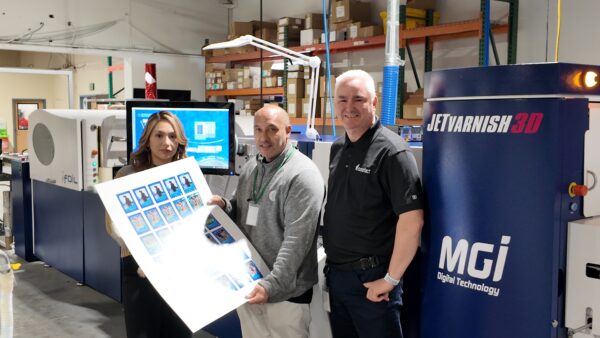Despite declining print volumes and the emergence of A4, the technology remains relevant.
We’ve been hearing about declining print volumes for at least a decade. Then along came COVID-19, accelerating the decline and creating an uncertain future for A3 technology. But what impact are these trends having on A3, the predominant technology in offices for so many years?
Robert Covington, product manager, Toshiba America Business Solutions (TABS), hasn’t seen any impact on customer buying habits because of COVID-19. “They weren’t printing, but when the bids started up again, they were buying the exact same thing,” he said, referring to A3. “COVID did cause a strain on the click volume and my aftermarket, there’s no question about it, but the flip side of it is that it got people embracing the concept of solutions, and our solutions become an easier sale.” (More on solutions and their relationship to A3 later).
Covington has seen a declining interest in high-volume departmental A3 devices. “The mid-range has gotten a boost at the expense of the departmental,” said Covington. “We’re looking at bolstering that segment of our product offering.”
Jim Coriddi, vice president, dealer division, Ricoh USA, has heard the projections that print volumes have dropped as much as 40% in some circles and are never coming back. He views that as an exaggeration. “When we think in terms of the new generation, they don’t print. But what we’re finding is that millennials do print. The millennials came into the workforce in offices where there was some influence from the Gen X Stone Age, where we utilize print. We’re starting to find that print is coming back. It’s not where it was, but in certain businesses, it’s grown a lot.”
Another argument in favor of the present and future relevance of A3 is the robustness of the technology. “Businesses need to be more efficient, and they need to manage their information more effectively,” said Coriddi. “A3 helps with the workflow, particularly now. This is the phenomenon that has really been exciting—the hybrid environment. Yes, you have people working from home, but now more and more, it’s a hybrid situation in the office. So, the ability to network and the ability to manage a consistent workflow is more important than it was before in some cases.”
Nobody is dismissing A4 as a viable technology. “A4 has its place, don’t get me wrong, but A4 is not designed for robust platforms nor is it as capable of handling the full suite of solutions that are required for digital workflows,” observed Coriddi.
Coriddi is referencing how A3 functions as a server for document workflow while also providing enhanced security. What Ricoh dealers have been selling, along with what they have on backorder, supports his argument. According to Coriddi, Ricoh is slightly above where it was in units sold prior to the pandemic.
Dino Pagliarello, senior vice president, product management and planning, Konica Minolta Business Solutions U.S.A., has no doubt there’s still life in A3. Still, he sees a mix of A3 and A4 technology in the workplace. Not that that isn’t happening now, but perhaps more so in the future. “We know A4 is growing. We know A3 has seen some decline, but it’s going to be a mix,” he said. “The mix may lean toward A4 going forward, but there are a lot of enhancements being made to the software that’s driving these products that you need both A3 and A4 in order to take advantage of those capabilities.”
That mix was one of the strategies Konica Minolta unveiled at its recent dealer meeting. Connectivity to the cloud, security, more apps, and a host of other capabilities are being built into the latest generation of the company’s A3 and A4 products. Other manufacturers are including similar capabilities in their A3 devices, as well making them more enticing to customers in a world where scanning to the cloud, doing more with less, and network and data security concerns are paramount.
Indeed, the success of A3 going forward will require dealers to focus more on the adjacent solutions bundled into the device rather than just copy, print, and scan. When Coriddi speaks of adjacent solutions, he’s referring to software such as DocuWare, PaperCut, and Ricoh’s Smart Integration (RSI) technology. The latter allows for scan-to-email and mobile printing, offers connectors for basic scanning to cloud accounts, and can streamline workflows.
TABS’s Covington is confident A3 is a viable technology for several reasons. “One, users are comfortable with it,” he said. “My gut tells me that the reliability and cost-efficiency of it for office use as a shared multiuse device makes more sense [than A4].” He noted that most A4 products aren’t perceived as durable or have as high of a duty cycle as the average A3 device. “When I get GeM bids, they’re asking for A3. They want something that can handle getting the doors kicked.” Another reason Covington believes A3 has a future is the finishing options, capabilities not typically associated with an A4 device.
Does Coriddi expect the post-COVID resurgence in A3 sales to continue? “Overall, there is absolutely a lot of life in A3, but it’s going to require dealers to have a more holistic solutions-oriented approach,” he responded. “There’s a huge opportunity for those A3 dealers in selling the adjacent solutions that go with it. They will continue to grow share. It will protect their profitability and secure their position with their customers. That’s what we’re building our whole dealer business model on.”
Konica Minolta’s Pagliarello agrees, even though he sees a future that will consist of a lot more A4 devices. “A4 is on the upswing, and we’re going to see fewer installations of A3, but A3 is not down and out,” he said. Even though it’s trending toward a decline, he believes the overall numbers remain in A3’s favor. “We’re talking about 60-something thousand machines [sold] last year,” he said. “That’s a lot of machines just in the A3 space. If we see a 2% or 3% decline per year, it’s got a pretty good run on it still. And you know, for us, it’s about taking share, making our customers happier, and continuing to help them with their transformational goals. If we could offer them a new A3 device, but they don’t have to have some of that physical hardware in their office—servers and things like that—needed to run their workflow, they’re saving money.”
Although the golden age of A3 is a thing of the past, going forward, we can expect to see the technology continue to reinvent itself as it offers more capabilities than ever before, thanks to new and improved solutions.
Access Related Content





